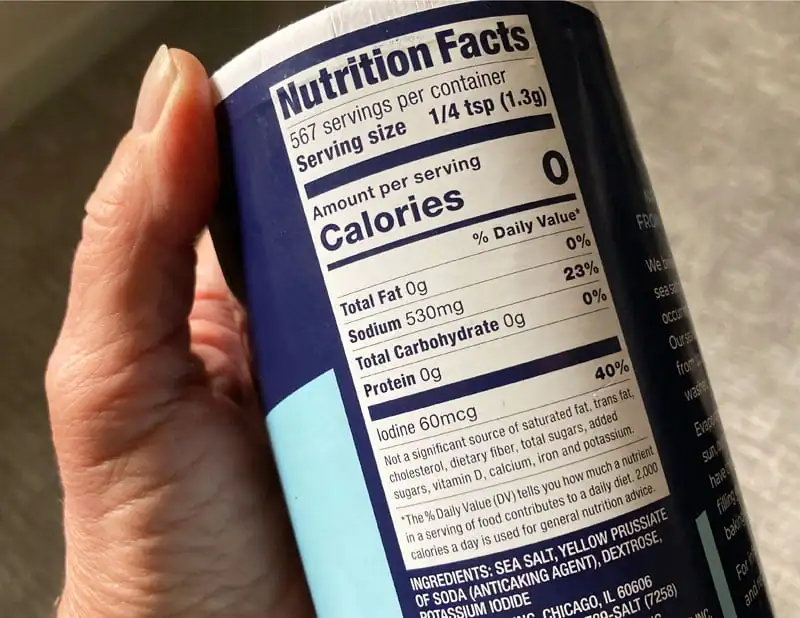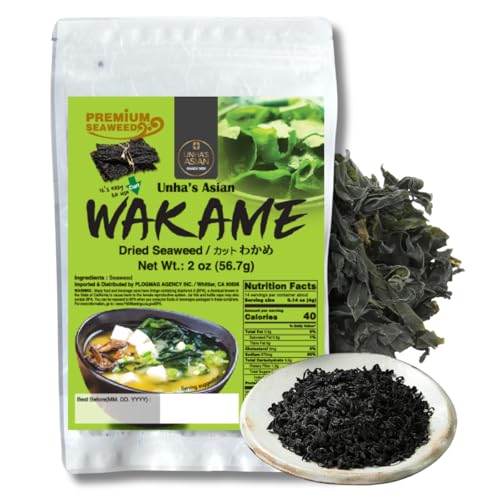While most of us have heard of Iodized Salt, have you ever stopped to think about what that is and why it is important to your health? In this article, we answer those questions and give you some background about how salt came to be fortified with Iodine. We also answer other commonly asked questions that come up about salt, trace minerals and intentional additives.
What is Iodized Salt?
Iodized salt is common table salt (sodium chloride – or NaCl) that has small amounts of the nutrient Iodine added to it.
Why should I care about Iodine in Salt?
Iodine is an essential mineral for the health of your body, in particular the function of your thyroid gland.
An insufficient amount of Iodine in your diet can cause a variety of problems related to your thyroid gland:
- Hypothyroidism: A lack of Iodine can cause the thyroid to not produce enough hormones, leading to fatigue, weight gain, and other problems with metabolism.
- Cretinism: Severe iodine deficiency during pregnancy can cause irreversible intellectual damage in the fetus and lead to developmental problems as the child grows up.
- Goiter: This is a condition where the thyroid gland swells up when the body tries to produce more hormones due to a lack of iodine.
There are also indications that Iodine plays a role in the body’s response to inflammation.
For links to scientific studies on the role of Iodine in diet, you may be interested in The Impact of Iodine Concentration Disorders on Health and Cancer.
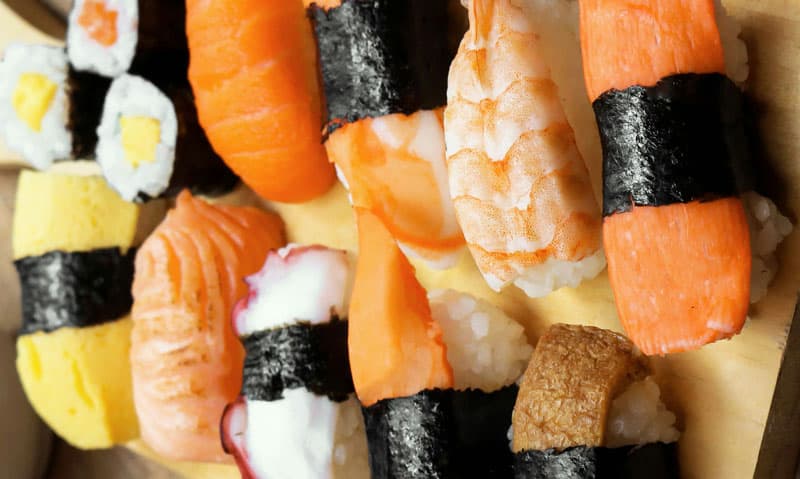
How Can I Get Iodine from My Diet?
Iodine rich foods tend to come from the ocean, or are concentrated from animal products when the animal consumes food from Iodine rich soil – typically milk and egg based items. Iodine-rich foods include:
- Fish from the Ocean – Tuna and Cod are examples
- Ocean seafood such as Shrimp
- Ocean plants, like various types of Seaweed
- Dairy products such as milk, yogurt and cheese are considered good sources of iodine, but the amount can vary depending on the cow’s diet.
Iodine intake is important enough that in 1924 the United States and Canada came up with a plan to make this nutrient easily available in the form of Iodized Salt. This was a highly successful plan because:
- People consistently consume salt in their daily diet
- Adding Iodine to salt (sodium chloride) was a simple process
- Adding Iodine to salt is fairly cheap to do
Selecting iodized salt for use in food preparation and baking is a simple way to insure that you are getting the iodine that you need in your diet. In particular, Vegans who do not eat fish or dairy foods, should make sure they are getting sufficient Iodine.
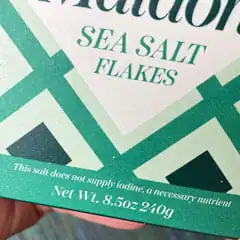
Many culinary salts, the kinds that we love to write about on this website do not contain Iodine, or contain only trace amounts that are not sufficient to meet daily requirements.
Examples include:
- Pink Himalayan Salt – also see our article Details On Iodine In Himalayan Salt: What You Need To Know
- Kosher Salt
- Sea Salts (Maldon, Fleur de Sel, Celtic, Baja, Hawaiian, etc.)
| Food | Serving Size | Iodine (in micrograms) |
| Nori Seaweed (used in Sushi) | 1 sheet (2.5 grams) | 63 mcg |
| Wakame Seaweed (used in Miso soup) | 1 tablespoon (1.5 grams) | 240 mcg |
| Plain Yogurt | 6 ounces | 56 mcg |
| Greek-style Yogurt | 6 ounces | 87 mcg |
| Chicken Egg * | 1 Large Egg (50 grams) | 26 mcg |
| Skim Milk * | 8 ounces | 85 mcg |
| Shrimp | 6 ounces | 70 mcg |
| Ahi Tuna | 6 ounces | 34 mcg |
| Iodized Salt * | 1/4 teaspoon (1.3 grams) | 60 mcg |
Note that some foods (marked with a * above) can be fortified with Iodine, so it’s good to check the packaging.
How Much Iodine Do You Need?
The amount of iodine you need in day depends on age and weight. Most adults should get 150 micrograms of iodine each day. If you are pregnant, and during breastfeeding, you should get 250 micrograms of iodine each day. Some prenatal vitamins contain Iodine, so be sure to check the label to determine how much you are getting.
How Much Iodine is in one serving of Iodized Salt?
It is possible that there is some variances between brands of salt, but typically you will get 60 micrograms from 1/4 teaspoon of iodized salt.
Frequently Asked Questions
What happens if you consume too much Iodine?
Oddly enough, the result of too much Iodine is very similar to Iodine deficiency: it interferes with the proper functioning of the thyroid gland and can cause goiter or increase the risk of certain types of cancer. The condition is called Hyperthyroidism (instead of hypo-). If you have concerns about consuming too much Iodine in your diet, good information about this condition is available here on the National Institute of Health site.
Is iodized salt more expensive?
Some brands of table salt may charge slightly more for iodized salt than non-iodized salt. It’s not that the additive or the fortifying process costs that much – it’s more about the business cost of providing two different products. In the case of Sea Salt or pink Himalayan salt that has been fortified with Iodine – expect to pay more just because the product is unusual or hard-to-find.
What’s the difference between Iodine and Iodide?
Iodine is a nutritional element and you may see it listed on the Nutritional Facts label on a food package. Iodide is a chemical compound that contains Iodine in combination with other elements, so an ingredient like Potassium Iodide is commonly what is used to fortify a food item with additional Iodine.
How does salt get Iodized?
The most common way to produce iodized salt is to add Potassium Iodide to the salt. A typical rate of fortification is 60 mcg of the Iodide to 1.3 grams (which is the same as 1300000 mcg). So it’s a really small amount, but it’s important!
By the way, Potassium Iodide is also a salt! For more on the chemical composition and uses of this salt, see What Is Salt?
Why isn’t Iodine listed on the Nutrition Facts label?
Iodine is not one of the required nutritional elements on the Nutritional Facts guidelines. It is an optional entry unless the food is intentionally fortified, so you may see foods that are high in Iodine list it (such as Seaweed). You will see Iodine listed on foods that are intentionally fortified, such as iodized salt products or eggs from chickens that have been fed iodine rich food.
What kinds of foods get fortified with Iodine?
While salt is the most frequently Iodized food stuff, commonly fortified items include eggs, milk, bread, prenatal vitamins and infant formula.
Which fruits are the highest in iodine?
Strawberries, prunes (dried plums) and cranberries are some of the best fruits to supply iodine.
Why wouldn’t I want iodized salt?
When using salt for food preservation, cooks avoid iodized salt. When pickling foods, too much iodine can affect the taste of the food and can cloud the pickling brine or discolor the pickled food. When curing meat, using iodized salt can concentrate too much iodine in the cured product. Pickling salt is typically non-iodized.
People who are undergoing treatment for thyroid issues should use or not use iodized salt based on the recommendations of their doctor.
Does cooking destroy iodine?
A very small amount of the iodine may dissipate due to evaporation, but most of the iodine will remain in the food when cooking with iodized salt.
How common is iodine deficiency?
Iodine is no longer very common due to iodized salt guidelines in most of the countries around the globe. It can still be an issue in developing countries, especially if they don’t have good access to ocean food products or have iodine deficient soils.
Can you get too much iodine from iodized salt?
Over consumption of iodine from salt intake is rare. Doctors do caution about getting too much iodine if you have a lot of Seaweed products in your diet. The amount of iodine in a single serving of Wakame, for example is four times the amount in a single serving of iodized salt.
Is iodized salt safe during pregnancy?
Yes it is safe – and in fact the suggested daily intake of iodine is higher for pregnant or nursing mothers (250 mcg) than for other adults (150 mcg).
Does iodized salt melt ice?
It does – but it’s the salt (sodium chloride) that assists the melting process. The presence of Iodine in the salt really makes no difference.
While it is possible to use iodized table salt to melt ice, there are far better (and cheaper) products to accomplish deicing – see selection guidelines at Best DeIcer – Which Salt to Choose for the Job.
Does iodized salt expire?
Salt does not really expire – but the added Iodine can very slowly dissipate through evaporation. While this probably is not enough to worry about, it’s best to use any fortified product by the “Best Used By” date if possible.
What’s the difference between ‘iodised’ and ‘iodized’?
Iodised is the correct term and spelling for British English. Iodized is the American English term and spelling. The meaning is exactly the same.
Is the salt in packaged foods iodized?
Typically, no, packaged foods like canned goods, frozen foods or boxed items like cracker or cookies use non-iodized salt. Check the Nutrition Facts labels for exceptions.
How can you tell if salt is iodized?
You can only tell if the salt is labeled as iodized – the appearance does not change and the change to the flavor is negligible.
Iodine-Rich Products
While iodized table salt is readily available in any grocery store, I thought I might list sources for a few of the less common products mentioned in this article.
Most pink Himalayan salt does not contain iodine, but I have located at least one brand where the US distributor adds a sufficent amount of iodine:
This salt starts as natural pink Himalayan salt from Pakistan, and then the folks that package it fortify the salt with Iodine. This link takes you to the coarse grain variety, but the supplier also has a fine ground type available. A 1/4 teaspoon serving of this salt provides 30 mcg of Iodine (20% of the daily requirement).
Wakame Seaweed is the kind that you often will see served in Miso soup when you go to a Japanese restaurant. It is super easy to use – I just sprinkle a bit of it into my Miso soup at home, too! It comes dried and will just absorb moisture from whatever dish you are making. The flavor is very mild – so it goes great in soups, casseroles, slow cooker meals and more.
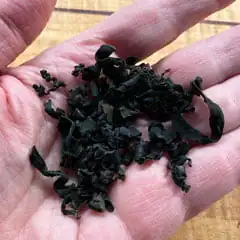
The only caution with Wakame is to not use too much – a single tablespoon (less than what is shown in my hand) will expand like something from a science project when it comes in contact with water.
The linked package has 2 ounces of seaweed, which may not sound like much, but ends up being over 37 tablespoons of dried seaweed (at 1.5 grams per tablespoon).
Dried wakame is easy to use and is a terrific source of Iodine in your diet! The traditional use for these flakes is to add them to Miso soup, but they go well into many soups, casseroles or slow cooker meals. This package contains 2 ounces (56.7 grams).
Snacking seaweed (usually Nori) has gotten more popular lately, to the point that you can start to find it available in regular grocery stores. I’ve been going to Japanese markets for years to stock up on all sorts of specialty items – and they are where I first found the seaweed snack that has remained my favorite. I will admit that these are a bit like the seaweed version of potato chips, but they are tasty – and a good source of Iodine:
Delicious seaweed snacks - these are one of my favorite splurges. Each bag contains 36 grams of snacks - seaweed is lightweight so you get quite a few snack size sheets in each bag. Packaged as a group of 6 bags.
Sushi Photo by Fadya Azhary.

